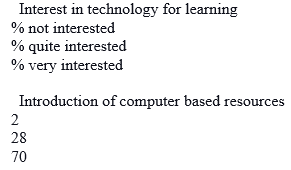Evidence indicates that the customary teaching approaches that focus on discourse, routine memorization, and high-stakes evaluation have done little to prepare students to address challenges faced in the real world (So & Curt 191). In this regard, more weight should be placed on constructive approaches that focus on computer-assisted collaborative tools. The article below focuses on my experience with collaborative computer tools in my teaching classes.
My experience with computer-assisted collaborative tools was thrilling. Unlike conventional teaching approaches, I noted that with collaborative tools, learning was more interesting and engaging. Through the approach, students were able to work in groups in coming up with solutions to the assigned tasks. I was required to play a vigorous role in facilitating learning. I noted that the teaching methodology enabled students to interact with one another, share information, and come up with concrete information in groups.
Because the approach emphasized more on combined activity and concerted learning, I noted that it was intrinsically grounded in constructivist and social cognitivist learning concepts compared to conventional teaching approaches (Bates 23). Indicated below are the CSCL concept map and multidisciplinary field.

In my teaching experience, I used Instagram to illustrate to my students about some activities. I also used the computer to come up with papers and presentations. Similarly, I allowed my students to access the teacher kit and to send their attachments through their emails.
The students were also able to engage in discussion forums and chats via the VLE. To use computer-assisted collaborative tools, students divide tasks into parts, which were then patched together at a later time. Thereafter, the students worked in groups to come up with solutions to the tasks. In groups, they worked together in distinguishing contradictory claims, evaluating evidence, and arguing their perspectives with one another to convey meaning. By doing so, they collaborated in solving problems, building products, and coming up with knowledge.
During the teaching experience, I noted that some computer-assisted collaborative tools were more effective compared to others. I noted that Instagram, email, chat, and blogs were effective compared to commercial based networks such as Facebook and Twitter. Based on this, I can ascertain that Facebook and Twitter did not work with my teaching lessons. The above sites were more complex to my students and had a lot of destructive content that compromised the students’ abilities to concentrate.
With respect to my teaching experience, I would recommend that computer-assisted collaborative tools should be adopted in all teaching lessons. The approach should be adopted in all schools because it is very effective compared to other customary approaches. I believe that if the approach is adopted, teachers will be able to prepare students to tackle real-world challenges they expect to encounter in their daily lives and later during their employment.
One of my colleagues posted that teachers should work closely with students when utilizing computer assisted collaborative tools. In support of his post, I believe that teachers should be able to assist the students whenever a challenge is presented with respect to the use of the above tools. Teachers should also ensure that the tools are used as intended and that their objectives are met
Works Cited
Bates, Tony. Study Book: Learning Theories for Online Education. Thousand Oaks, Calif.: SAGE Publications, 2014. Print.
So, Hyo-Jeong and Curt Bonk. “Examining the Role of Blended Learning Approaches in Computer-supported Collaborative Learning Environments.” Journal of Educational Technology and Society, 13.3 (2013): 189-200. Print.